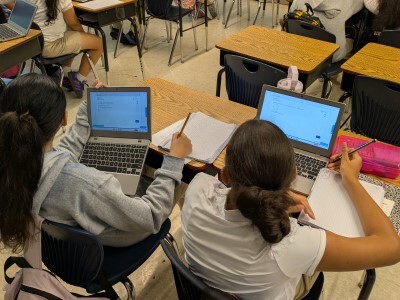Making Math Meaningful: A Just-in-Time, Problem-Based Approach
Topics

We’ve all had the experience of truly purposeful, authentic learning and know how valuable it is. Educators are taking the best of what we know about learning, student support, effective instruction, and interpersonal skill-building to completely reimagine schools so that students experience that kind of purposeful learning all day, every day.
Mathematics as a discipline was developed to solve real problems. It should be the problems that drive what our students learn, not vice versa.
“How do I write an equation for exponential decay?” one of my students asked me recently. “I’m trying to predict when Indian elephants will become critically endangered.”
I’m a high school math teacher; I’ve spent my career answering questions about math. But until recently, I’d rarely heard my students articulate why they were asking these questions in the first place. Sure, my students wanted good grades, or college recommendations, or any number of other extrinsic rewards. But intrinsic curiosity about mathematics? That was much harder to instill.
As teachers we have difficult jobs: we’re told what we have to teach, and it doesn’t always fit with what students find interesting. For many years I did my best to teach content first, and then—once students had mastered what I’d taught them—to show them interesting applications of that material. But time was limited, my energy was finite, and the great projects I had planned, those really interesting questions at the end of each unit, were cut short. No wonder, I realized, students saw learning as an endless slog toward grades.
For the past few years, however, I’ve tried a different tack, and this year I’ve jumped ship altogether. I don’t really teach content anymore. Rather, I give my students interesting projects—like predicting future changes to a population of their choosing—that require them to learn that content, and then lead them in acquiring the specific skills they need to answer the questions they’ve posed. My students no longer ask me why they need to learn things. Instead they tell me what they need to know, so that I’ll help them learn.
Solving Real Problems with Math
Take a foundational concept in high school mathematics: the function. A function is, essentially, a mathematical description of a relationship between two quantities that change. Time and height, for instance, or temperature and ice-cream sales. We use functions to model changes to populations, to the weather, to the economy, and to countless other quantities we care about.
Now think back to your own high school math education. Did you learn functions the way that architects and doctors and stockbrokers use them—to better understand, and make better decisions in, the real world? Or were you taught functions as abstract manipulations of x and y, just in case you’d ever need to do something interesting with them at some undefined point in the future?
My guess is, unfortunately, that you learned functions—and many other of the most useful concepts ever developed by humankind—“just in case.” Students today certainly learn in the same way: the Common Core State Standards for Mathematics denote modeling standards with an asterisk, as if learning to create mathematical models were just a bonus feature of learning abstract math content. In fact, it’s exactly the opposite—modeling is the whole point! Mathematics as a discipline was developed to solve real problems. It should be the problems that drive what our students learn, not vice versa.
In my classroom, therefore, students don’t begin the functions unit with definitions or reviews of foundational skills. Rather, they begin by reading about population growth and finding populations they want to study. Once they’re curious about how those populations will change, it’s easy to show them how functions can help—and they’re eager to learn the techniques they need. I use the same approach for trigonometry, geometry, and statistics, in which my students learn to measure heights, design houses, analyze data sets, and so on. My students never ask, “When will I ever use this?” Instead, they ask, “How can I use this to solve problems I care about?”
This approach isn’t easy, and it’s taken me years to find the problems and projects that will motivate authentic learning. And it’s easier for some topics than for others—especially when particularly hard-to-apply topics are ones my syllabus requires me to teach. Yet I often find myself asking: if I can’t think of an interesting problem that my students need a specific skill to answer, why teach it at all?
Teaching Skills by Using Them
Rather than teaching skills “just in case,” we need to start teaching our students the skills they need, “just in time” for them to use them. We should design standards and assessments across the curriculum with this principle in mind. We don’t need to teach students grammar; inspire them to write good stories, and the grammar will come. We don’t need to teach the Bill of Rights; engage them in political debate, and the constitutional analysis will come. The same goes for foreign languages, for the laws of physics, for coding, and for anything and everything else worth learning. As adults, we don’t have the time or the energy to learn things “just in case.” Why should we treat our students any differently?
Our young people are our future. We can’t afford to keep giving them solutions to problems that long ago were solved—we should be preparing them, now, to confront the real challenges that they, and our world, will face. (Saving the Indian elephant, for one!) We should be giving them meaningful problems to solve and the skills, as well as the mindset, they’ll need to find solutions. That starts with us as teachers, in our classrooms. It should start now.
Photo courtesy of Allison Shelley/The Verbatim Agency for American Education: Images of Teachers and Students in Action.




